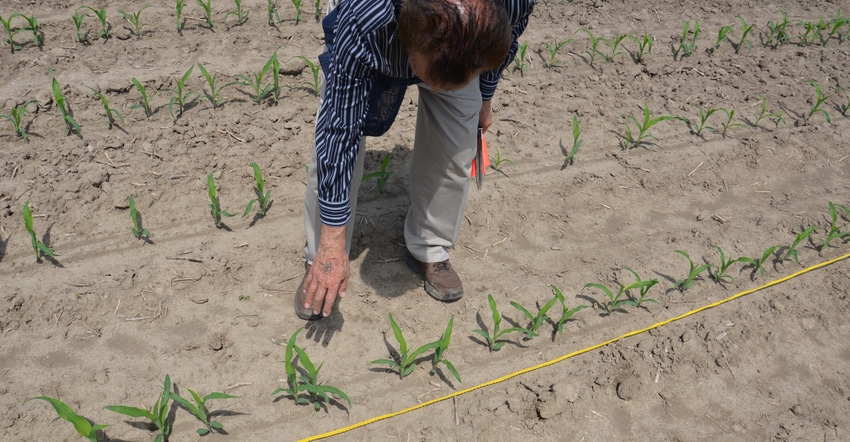
The Corn Watch ’19 field was planted May 28, about four weeks behind schedule. Perhaps your corn was planted even later than that. How do you know what lies ahead for late-planted corn, especially if it’s already been through periods of saturated soils and cool weather?
Remember the basics of good corn management, just like you would any other year. That’s the advice from Dave Nanda, director of genetics for Seed Genetics-Direct, Jeffersonville, Ohio. He will monitor the Corn Watch ’19 field all year. Seed Genetics-Direct sponsors Corn Watch ’19.
“One of the first things is to establish what kind of plant population you have,” he says. “If you haven’t done so already, do it now.”
Nanda carries a yellow rope with metal stakes on each end just for this purpose. It’s marked with tags for varying row widths. Since this field is in 30-inch rows, by counting the stand in 17 feet, 5 inches of row and multiplying by 1,000, you can determine thousands of plants per acre.
Nanda typically counts plants in rows on both sides of the rope and then averages the counts together. For example, if he finds 31 in one row and 32 in another, the average is 31.5, or 31,500 plants per acre.
Here are other things to watch:
Yield potential. Using the Purdue University Corn and Soybean Field Guide, a field planted May 28 vs. May 1 with 31,500 plants per acre should have about 85% of original yield potential. Average yield on this farm is typically around 220 bushels per acre. That means on average, you could expect 187 bushels per acre, Nanda says. However, he adds that weather will play a big role. With favorable weather conditions and a good stand, the crop could recapture some of that yield potential.
Nitrogen availability. Several reports of yellow corn circulated near the end of June. Even in this field, with roughly 200 pounds of actual N applied in various forms in the spring before planting, some yellowish tint appeared during a stretch of 10 consecutive days of rain; a total of more than 5 inches fell, all in mid- to late June. Once drier weather returns, it will be easier to judge how much N might have been lost, Nanda says.
Cool temperatures. The third full week of June averaged nearly 2 degrees F below normal statewide, notes Greg Matli, state statistician with USDA’s National Agricultural Statistics Service. That’s not what late-planted corn needs, Nanda notes. It needs to accumulate growing degree days, which build up when temperatures don’t exceed 86 degrees during the day or fall below 50 degrees at night.
Faster maturity effect. Bob Nielsen, Purdue University Extension corn specialist, notes that the same hybrid planted May 28 should reach black layer with about 200 fewer GDDs than if it were planted May 1. The trick is accumulating enough GDDs so that happens before the first killing freeze, Nanda says.
Plants under water. Roughly 1 to 2 acres of the Corn Watch ’19 field were under water for one to two days after the heaviest part of the rain events in mid- to late June. Whether plants are completely submerged and for how long matters, Nielsen says. In this case, the water went down fast enough that nearly all plants survived.
About the Author(s)
You May Also Like




